East Yorkshire Regiment
| East Yorkshire Regiment (The Duke of York's Own) | |
|---|---|
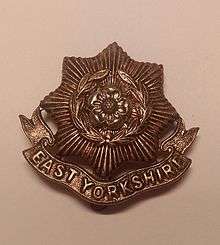 Cap badge of the East Yorkshire Regiment. | |
| Active | 1685–1958 |
| Country |
|
| Branch |
|
| Type | Infantry |
| Role | Line infantry |
| Size |
1-2 Regular battalions 1 Militia Battalion 2 Territorial battalions Up to 16 Hostilities-only battalions |
| Garrison/HQ | Victoria Barracks, Beverley |
| Anniversaries | Quebec (13 September) |
The East Yorkshire Regiment was a line infantry regiment of the British Army, first raised in 1685 as Sir William Clifton's Regiment of Foot. It saw service for three centuries, before being amalgamated with the West Yorkshire Regiment (Prince of Wales's Own) to form the Prince of Wales's Own Regiment of Yorkshire in 1958. Subsequently, the regiment amalgamated with the Green Howards and the Duke of Wellington's Regiment (West Riding) to form the Yorkshire Regiment (14th/15th, 19th and 33rd/76th Foot) on 6 June 2006.
History
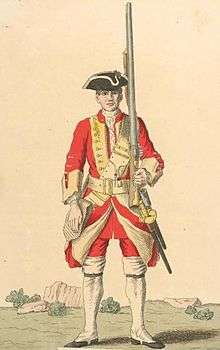
.jpg)
Raised in 1685 in Nottingham by Sir William Clifton, 3rd Baronet,[1] the regiment was originally, like many British infantry regiments, known by the name of its current Colonel.[2] It fought at the Battle of Blenheim in 1704 during the War of the Spanish Succession,[3] the Jacobite Rising of 1719[4] and at the Battle of Cartagena de Indias in 1741 during the War of Jenkins' Ear.[5] In 1751, when the numerical system of designation of Regiments of Foot was adopted, it became the 15th Regiment of Foot.[2]
The regiment went on to take part in the capture of Île-d'Aix in 1757 [6] and the Battle of the Plains of Abraham in 1759 during the Seven Years' War.[7] In 1782 the regiment became the 15th (The Yorkshire East Riding) Regiment of Foot.[2] It again fought in the West Indies during the Napoleonic Wars, taking part in the invasions of Martinique and Guadeloupe.[8]
The regiment spent most of the 19th century on garrison duty, both at home and throughout the Empire. The 1st Battalion was shipped to New Brunswick in 1862 at the time of the Trent Affair, when Britain and the United States came close to war. With the Childers Reforms of 1881, it became The East Yorkshire Regiment, the County Regiment of the East Riding of Yorkshire.[2] The 2nd Battalion fought in the Second Anglo-Afghan War and the Second Boer War.[9]
First World War

Regular Army
The 1st Battalion landed at Saint-Nazaire as part of the 18th Brigade in the 6th Division in September 1914 for service on the Western Front.[10] The 2nd Battalion landed at Le Havre as part of the 83rd Brigade in the 28th Division in January 1915 also for service on the Western Front before moving to Salonika in October 1915 for service on the Macedonian Front.[10]
Territorial Force
The 1/4th Battalion landed at Boulogne-sur-Mer as part of the York and Durham Brigade in the Northumbrian Division in April 1915 for service on the Western Front.[10]
New Armies
The 6th (Service) Battalion landed at Suvla Bay in Gallipoli as the pioneer battalion for the 11th (Northern) Division in August 1915; the battalion was evacuated in January 1916 and then landed at Marseille in July 1916 for service on the Western Front.[10] The 7th (Service) Battalion landed at Boulogne-sur-Mer as part of 50th Brigade in the 17th (Northern) Division in July 1915 also for service on the Western Front.[10] The 8th (Service) Battalion landed at Boulogne-sur-Mer as part of the 62nd Brigade in the 21st Division in September 1915 also for service on the Western Front.[10]
The 10th, 11th, 12th and 13th (Service) Battalions were raised in September 1914 from men volunteering in Hull. These units were additionally entitled 1st, 2nd, 3rd and 4th City of Hull battalions. They landed in Egypt as part of the 92nd Brigade in the 31st Division in December 1915 and then moved to France in March 1916 also for service on the Western Front.[10]
Between the wars
In 1935 the regiment was renamed The East Yorkshire Regiment (The Duke of York's Own), after its Colonel-in-Chief.[2]
Second World War
In the Second World War, six hostilities-only battalions were raised. The 1st Battalion was serving in British India on the outbreak of war in 1939 and did not see active service until 1942 when the Empire of Japan entered the war. The battalion fought in the Burma Campaign in many different British Indian Army brigades. The regiment fought in the Battle of France and was evacuated at Dunkirk. It took part in the invasion of Normandy, the liberation of Western Europe, the North African Campaign, the Invasion of Sicily and the Burma Campaign.[11]
The 2nd Battalion served with the 8th Infantry Brigade (which included the 1st Suffolks and 1st South Lancs), attached to the 3rd Infantry Division throughout the whole war. At the time, the 3rd Division was commanded by Major-General Bernard Montgomery, who would later command the Anglo-Canadian 21st Army Group. The battalion and division were sent to France in late 1939 as part of the British Expeditionary Force and remained there until May 1940 when they fought in the Battle of France and were evacuated at Dunkirk. After Dunkirk, the battalion and division spent many years on home defence anticipating a German invasion of England. After late 1942 when the threat of invasion receded, they then started training for offensive operations and, in mid-1944, invaded Normandy, France.[11]
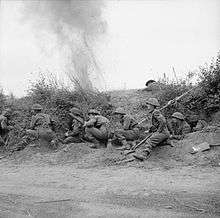
The 4th Battalion was a 1st Line Territorial Army unit serving in the 150th Infantry Brigade in the 50th (Northumbrian) Infantry Division and, like the 2nd Battalion, served in France 1940, were evacuated at Dunkirk to England and remained in the United Kingdom with the division until mid-1941 when it was sent to the Middle East.[12]
The 5th Battalion was formed in 1939 as a 2nd Line Territorial Army duplicate of the 4th Battalion. It served with the 69th Infantry Brigade in the 50th (Northumbrian) Infantry Division.[13]
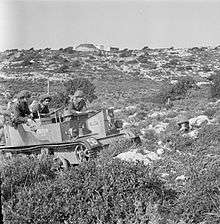
After the War
The regiment was in Mandatory Palestine during the Zionist insurgency and then took part in the Malayan Emergency in 1953–56 before returning to Germany as part of the British Army of the Rhine. In 1958, it was amalgamated with The West Yorkshire Regiment (The Prince of Wales's Own), to form the Prince of Wales's Own Regiment of Yorkshire.[2]
Battle honours
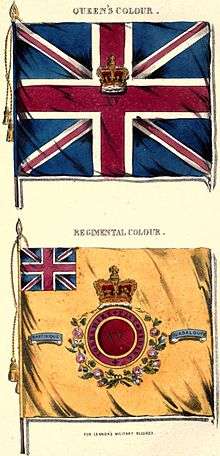
The regiment’s battle honours were as follows:[2]
- Blenheim, Ramillies, Oudenarde, Malplaquet, Louisburg, Quebec 1759, Martinique 1762, Havannah, St. Lucia 1778, Martinique 1794 1809, Guadeloupe 1810, Afghanistan 1879-80, South Africa 1900-02
- The Great War (21 battalions): Aisne 1914 '18, Armentières 1914, Ypres 1915 '17 '18, Gravenstafel, St. Julien, Frezenberg, Bellewaarde, Hooge 1915, Loos, Somme 1916 '18, Albert 1916 '18, Bazentin, Delville Wood, Pozières, Flers-Courcelette, Morval, Thiepval, Ancre Heights, Ancre 1916, Arras 1917 '18, Scarpe 1917 '18, Arleux, Oppy, Messines 1917 '18, Pilckem, Langemarck 1917, Menin Road, Polygon Wood, Broodseinde, Poelcappelle, Passchendaele, Cambrai 1917 '18, St. Quentin, Bapaume 1918, Rosières, Lys, Estaires, Hazebrouck, Kemmel, Scherpenberg, Amiens, Hindenburg Line, Épéhy, Canal du Nord, St. Quentin Canal, Selle, Sambre, France and Flanders 1914-18, Struma, Doiran 1917, Macedonia 1915-18, Suvla, Landing at Suvla, Scimitar Hill, Gallipoli 1915, Egypt 1915-16
- The Second World War: Withdrawal to Escaut, Defence of Escaut, Defence of Arras, French Frontier 1940, Ypres-Comines Canal, Dunkirk 1940, Normandy Landing, Tilly sur Seulles, Odon, Caen, Bourguébus Ridge, Troarn, Mont Pincon, St. Pierre la Vielle, Gheel, Nederrijn, Aam, Venraij, Rhineland, Schaddenhof, Brinkum, Bremen, North-West Europe 1940 '44-45, Gazala, Mersa Matruh, Defence of Alamein Line, El Alamein, Mareth, Wadi Zigzaou, Akarit, North Africa 1942-43, Primosole Bridge, Sicily 1943, Sittang 1945, Burma 1945
Victoria Cross recipients
The following members of the regiment were awarded the Victoria Cross:
- Private George William Chafer, Great War
- Private John Cunningham, Great War
- Second Lieutenant John Harrison, Great War
- Sergeant Harold Jackson, Great War
- Private Eric Anderson, Second World War
Colonels of the Regiment
Colonels of the regiment included:[2]
- 1685–1686: Col. Sir William Clifton, 3rd Baronet
- 1686–1687: Col. Arthur Herbert, 1st Earl of Torrington
- 1687–1688: Col. Hon. Sackville Tufton
- 1688–1695: Col. Sir James Lesley
- 1695–1709: Lt-Gen. Hon. Emanuel Scrope Howe
- 1709–1715: Gen. Algernon Seymour, 7th Duke of Somerset and Earl of Hertford
- 1715–1749: Lt-Gen. Henry Harrison
- 1749–1756: Col. John Jordan
The 15th Regiment of Foot
- 1756–1768: F.M. Sir Jeffrey Amherst, 1st Baron Amherst, KB
- 1768–1775: Lt-Gen. Sir Charles Hotham-Thompson, 8th Baronet, KB
- 1775–1778: Lt-Gen. Richard Lambart, 6th Earl of Cavan
- 1778–1792: Gen. Sir William Fawcett, KB
The 15th (York, East Riding) Regiment
- 1792–1794: Gen. James Inglis Hamilton
- 1794–1814: Gen. Henry Watson Powell
- 1814–1846: Gen. Sir Moore Disney, KCB
- 1846–1850: Gen. Sir Phineas Riall, KCH
- 1850–1851: Maj-Gen. Sir Henry Watson, CB
- 1851–1861: Gen. Sir Howard Douglas, 3rd Baronet, GCB, GCMG
- 1861–1868: Lt-Gen. William Booth
- 1868–1877: Gen. Thomas Armstrong Drought
- 1877–1888: Gen. Sir William Montagu Scott McMurdo, GCB
The East Yorkshire Regiment
- 1888–1889: Gen. Edward George Wynyard
- 1889–1890: Gen. John Hope Wingfield
- 1890–1891: Gen. Robert Bruce
- 1891–1897: Gen. Edward Westby Donovan
- 1897–1901: Lt-Gen. William Hardy, CB
- 1901–1920: Maj-Gen. Sir Coleridge Grove, KCB
- 1920–1925: Maj-Gen. Francis Seymour Inglefield, CB, DSO
- 1925–1930: Maj-Gen. Sir Gerald Farrell Boyd, KCB, CMG, DSO, DCM
- 1930–1933: Brig-Gen. Henry Haggard
- 1933–1940: Brig-Gen. John Louis Justice Clarke, CMG
- 1940–1948: Lt-Gen. Sir Desmond Francis Anderson, KBE, CB, CMG, DSO
- 1948–1958: Brig. Robert John Springhall, CB, OBE
References
- ↑ Christopher Chant (18 October 2013). The Handbook of British Regiments (Routledge Revivals). Routledge. pp. 153–. ISBN 978-1-134-64724-8.
- 1 2 3 4 5 6 7 8 Mills, T.F. "The East Yorkshire Regiment (The Duke of York's Own)". regiments.org. Archived from the original on 30 December 2006. Retrieved 5 February 2007.
- ↑ Cannon, p. 19
- ↑ Cannon, p. 29
- ↑ Cannon, p. 32
- ↑ Cannon, p. 37
- ↑ Cannonn, p. 42
- ↑ Cannon, p. 61
- ↑ "The East Yorkshire Regiment". Anglo-Boer war. Retrieved 10 March 2016.
- 1 2 3 4 5 6 7 "East Yorkshire Regiment". The Long, Long Trail. Retrieved 10 March 2016.
- 1 2 "East Yorkshire Regiment". British Armed Forces. Retrieved 10 March 2016.
- ↑ Joslen, p. 334
- ↑ Joslen, p. 81
Sources
- Cannon, Richard (1848). Historical record of the 15th or the Yorkshire East Riding Regiment of Foot: containing an account of the formation of the regiment in 1685 and of its subsequent services to 1848. Parker Furnivall & Parker.
- Joslen, Lt-Col H.F. (2003). Orders of Battle, United Kingdom and Colonial Formations and Units in the Second World War, 1939–1945. Uckfield: Naval & Military Press. ISBN 1-84342-474-6.